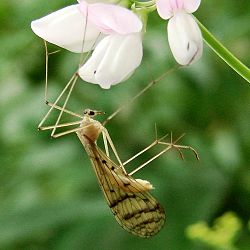| Bittacus Temporal range: | |
|---|---|
 | |
| Bittacus strigosus | |
| Scientific classification | |
| Domain: | Eukaryota |
| Kingdom: | Animalia |
| Phylum: | Arthropoda |
| Class: | Insecta |
| Order: | Mecoptera |
| Family: | Bittacidae |
| Genus: | Bittacus Latreille, 1805 |
| Species | |
See text | |
Bittacus is a genus of hangingflies in the order Mecoptera. Members of the genus have a cosmopolitan distribution. The genus has existed since at least the earliest Late Cretaceous. [1] Bittacus is considered "grossly paraphyletic" and serves as a catch-all for many distantly related species of hangingflies. [2]